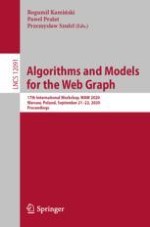2020 | Buch
Algorithms and Models for the Web Graph
17th International Workshop, WAW 2020, Warsaw, Poland, September 21–22, 2020, Proceedings
herausgegeben von: Dr. Bogumił Kamiński, Paweł Prałat, Dr. Przemysław Szufel
Verlag: Springer International Publishing
Buchreihe : Lecture Notes in Computer Science
